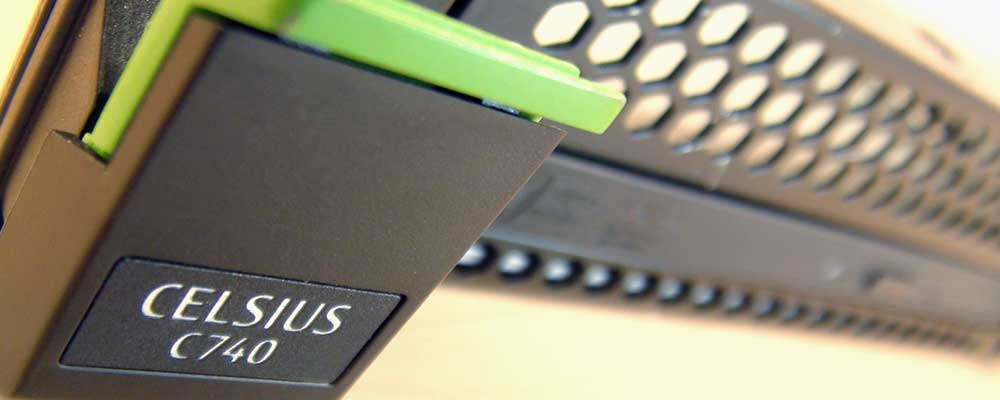
Is your company considering implementing remote workstation solutions? If so, then the Bavarian CELSIUS workstation team might have the perfect solution for you.
PGW recently spoke with the CELSIUS workstation team about the new CELSIUS C740 1U rack-mounted workstation. This system does more than simply build on the foundations laid by the previous model, the new CELSIUS C740 delivers completely new capabilities and performance.
This new generation of rack workstation makes major technology advances yet maintains a 1U format. New technology has been added to the workstation at nearly every level, and the system offers an expandability related to graphics, processors, and memory.
This system, like all of the CELSIUS family, is designed and manufactured in Germany. For product design, right down to the mother board, to manufacturing and final test, the Augsburg team is in control.
The key benefits of remote workstation solutions are:
-
data security : your critical data never leaves your data center
-
accessibility : a powerful workstation is available where ever you are and from any device
-
efficiency : easy to deploy and manage workstation resources
And significant benefits of the Fujitsu CELSIUS C740, include:
-
multi-user virtual GPU capable with NVIDIA GRID vGPU Technology
-
extremely dense, 1U remote workstation format
-
extremely expandable with flexible configuration options
-
designed and manufactured in Germany
Fujitsu Business Development Manager, Manuel Gremes, takes us on a tour of the CELSIUS C740 rack-mounted workstation.
The CELSIUS C740 balances size and capacity to provide an extremely dense remote workstation design. Capacity means more configuration options which makes the CELSIUS C740 adaptable to workflows that stretch from 3D design, to CAD, to simulation & analysis, to rendering and visualization.
Our take on the CELSIUS C740 is simple: It is easily the most interesting remote workstation among the new generation of products that we have seen. Fujitsu Business Development Manager, Manuel Gremes, takes us on a very complete tour of the new system in this report video.
In just eight minutes, he compares the new system to the old, walks through the technology highlights, and demonstrates the remote workstation performance live. So grab your coffee and spend a few minutes with Mr. Gremes to learn more about this remote graphics workstation.
By designing a powerful system in a 1U rack workstation format, by using NVIDIA GRID vGPU technology, the Teradici GPU-pass-through solution, and supporting the latest CPUs and 256 GB of memory, the CELSIUS C740 is easily one of the most, if not the most, interesting remote workstation solutions PGW has looked at so far.
The CELSIUS C740 is the most interesting remote workstation design we have seen so far
First and foremost, the CELSIUS C740 is a rack-mounted workstation designed for remote workstation installations. The new technologies enable a single, remote workstation to be configured optimally for the two primary use-cases for a virtualized workstation:
-
a one-to-one connection with GPU-pass-through or
-
a virtual GPU connection
And the CELSIUS C740 offers expandability which allows customers to configure the remote workstation for two very different engineering domains, namely:
-
high-end interactive 3D modeling and interactive visualization, and
-
computer-aided engineering applications, rendering, and video processing.
Why is this true? Let's look at the virtualized environment first.
For remote workstation connectivity, IT managers can choose to configure a system with a dedicated GPU for each user. This is a one-to-one connection and the full power of the GPU is provided to the remote user through a technology commonly referred to as GPU-pass-through.
NVIDIA GRID Technology is transforming remote graphics workstation solutions today
With NVIDIA GRID technology, the CELSIUS C740 remote workstation can also be configured to support eight users using virtualized GPUs for each user. NVIDIA refers to this as their “vGPU” technology. In this scenario, the NVIDIA GRID technology provides the GPU virtualization. Then the workstation's support for 256 GB of memory and the latest Intel Xeon E5-2600 processor with up to 18 cores provide the horsepower for a multi-user, engineering and analysis system. Together, Fujitsu delivers a powerful, multi-user, remote workstation solution.
Regarding different engineering domains, the new graphics, processor, and memory options allow customers to address dramatically different project demands.
As we have often seen, interactive 3D modeling benefits from powerful graphics and fast processors, but does not require many cores. Where as simulation, rendering, and video can use as many cores as a system can offer.
And so, for the second question, the configuration options on the CELSIUS C740 allow you to select a workstation that best suits your demands – whether those demands are interactive 3D CAD or CAE analysis and simulation.
This rack workstation can support either a double-wide graphics card like the ultra-high-end NVIDIA Quadro K5200 in the system we saw, or two high-end or mid-range NVIDIA Quadro K4200 and Quadro K2200 GPUs, respectively. By using two high-end GPUs and the fastest possible quad-core CPU, two remote users can be given an extremely capable interactive 3D workstation each.
If your needs lean towards CAE with more demands on simulation and analysis, two NVIDIA Quadro K2200 GPUs, an 18 core Intel Xeon CPU, and 256 GB of memory will provide your team with two very powerful one-to-one connections for remote workstation engineering.
Using NVIDIA GRID technology, the CELSIUS C740 can support up to eight simultaneous users in a 1U rack-mounted workstation. With support for many-core CPUs and 256 GB of memory, the system can easily adapt to the requirements of most product development teams and provide a very dense, remote workstation computing infrastructure.
With a nearly endless list of enhancements, the CELSIUS C740 appears to be much more than an evolution from the previous generation. By using the latest NVIDIA GRID vGPU technology, by supporting many-core CPUs, and by increasing memory capacity to 256 GB, this new system expands the remote workstation environments offered as well as the engineering domains the system is able to address.





